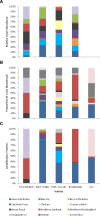Supersuppression: Reservoir Competency and Timing of Mosquito Host Shifts Combine to Reduce Spillover of West Nile Virus
- PMID: 27503511
- PMCID: PMC5094236
- DOI: 10.4269/ajtmh.15-0809
Supersuppression: Reservoir Competency and Timing of Mosquito Host Shifts Combine to Reduce Spillover of West Nile Virus
Abstract
In the eastern United States, human cases of West Nile virus (WNV) result from spillover from urban epizootic transmission between passerine birds and Culex mosquitoes. In Atlanta, GA, substantial WNV presence in hosts and vectors has not resulted in the human disease burden observed in cities with similar infection pressure. Our study goal was to investigate extrinsic ecological conditions that potentially contribute to these reduced transmission rates. We conducted WNV surveillance among hosts and vectors in urban Atlanta and recorded an overall avian seroprevalence of nearly 30%, which was significantly higher among northern cardinals, blue jays, and members of the mimid family, and notably low among American robins. Examination of temporal Culex feeding patterns showed a marked feeding shift from American robins in the early season to northern cardinals in the late season. We therefore rule out American robins as superspreaders in the Atlanta area and suggest instead that northern cardinals and mimids act as WNV "supersuppressor" species, which slow WNV transmission by drawing many infectious bites during the critical virus amplification period, yet failing to amplify transmission due to low host competencies. Of particular interest, urban forest patches provide spillover protection by increasing the WNV amplification fraction on supersuppressor species.
© The American Society of Tropical Medicine and Hygiene.
Figures






References
-
- Kramer LD, Styer LM, Ebel GD. A global perspective on the epidemiology of West Nile virus. Annu Rev Entomol. 2008;53:61–81. - PubMed
-
- CDC West Nile Virus Infection. 2015. http://www.cdc.gov/westnile/index.html Available at. Accessed May 28, 2016.
-
- CDC Provisional surveillance summary of the West Nile virus epidemic: United States, January–November 2002. Morb Mortal Wkly Rep. 2002;51:1129–1133. - PubMed
MeSH terms
Grants and funding
LinkOut - more resources
Full Text Sources
Other Literature Sources
Medical

